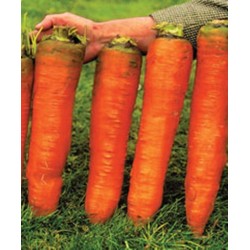Menu
-
Menuالعدمة
- Home
-
التصنيفات
-
-
التصنيفات
-
بذور الخضروات
-
أصناف حسب البلد
- أصناف من أرمينيا
- أصناف من البوسنة والهرسك
- أصناف من كرواتيا
- أصناف من فرنسا
- أصناف من ألمانيا
- أصناف من اليونان
- أصناف من المجر
- أصناف من الهند
- أصناف من إيطاليا
- أصناف من اليابان
- أصناف من شمال مقدونيا
- أصناف من بيرو
- أصناف من روسيا
- أصناف من صربيا
- أصناف من سلوفينيا
- أصناف من اسبانيا
- أصناف من تايلاند
- أصناف من تركيا
- أصناف من الولايات المتحدة الأمريكية
- بذور الطماطم
- بذور الذرة
- عائلة القرع
- الفول الأسرة
- بذور الخيار
- بذور الفلفل
- عائلة الجزرة
- عائلة البصل
- بذور الخس
- عائلة البطاطس
- عائلة الملفوف
- بذور الفجل
- عائلة الشمندر
- بذور البطيخ
- بذور بطيخ
- بذور القرنبيط
- عائلة عباد الشمس
-
أصناف حسب البلد
- بذور الفاكهة
- بذور الفلفل الحار
- بذور عشبة طبية
- تسلق بذور النباتات
- الأشجار - بذور بونساي
- بذور النخيل
- بذور الأعشاب الزينة
- بذور التبغ
-
بذور الخضروات
-
-
-
-
- منتجات جديدة
- التسليم - الدفع
- انشئ حساب
- FAQ
Last Product Reviews
These peppers came all the way from eastern Europe and took a while at no f...
By
 Fitim Berani on 21/09/2023
Fitim Berani on 21/09/2023
Verified Purchase
Last customers
- Tanja, Beograd, Serbia
- Lasse, 2900, Norway
- Pete, Cleves, United States
- Stef, Waalwijk, Netherlands
- Sonia, Minervino di Lecce, Italy
- Adrian, Ingolstadt, Germany
- CORINNE, NOTRE DAME DE LONDRES, France
- Dušan, KRAVANY NAD DUNAJOM, Slovakia
- Arno, Ehrenkirchen, Germany
- Costas, LARNACA , Cyprus
- Fulvio francesco, Santa Domenica Talao, Italy
- william, Dun, France
- Aymeric , Saint tricat, France
- Ricard, Sant Celoni, Spain
- Maureen , Enniscorthy Co Wexford , Ireland
- Paul, St. Vigil in Enneberg (BZ), Italy
- Ricardo jorge , Viseu , Portugal
- Radosav, Kragujevac, Serbia
- Sylvie, Neyruz, Switzerland
- Julien, Scionzier, France
- Zoran, Vinca, Serbia
- Josef, Hochdorf-Assenheim, Germany
- Davide, London, United Kingdom
- Kimberly, Victoria, Gozo, Malta
- Saša , Beograd, Serbia
- Ewa, Galway, Ireland
- Ioannis , Kato Achaia, Greece
- Samuele, Milano, Italy
- Dubravka, Niš , Serbia
- Theodoros, Grevena, Greece
يوجد 43 منتجا.
عرض 13-24 من 43 منتجات
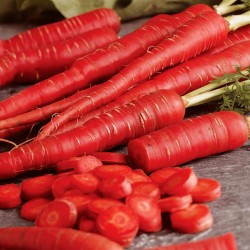
Carrot Seeds Atomic Red
السعر
1.50 €
SKU: VE 20 R
Seeds Gallery Com,
5/
5
<h2><strong>Carrot Seeds Atomic Red</strong></h2>
<h2><span style="color:#ff0000;"><strong>Price for Package of 25 seeds.</strong></span></h2>
<p>The Atomic Red carrot lives up to its name — its 11” long tapered roots are a beautiful scarlet color that gets brighter when cooked. This variety gets its hue from healthful Lypocene, a precursor to beta carotene credited for helping prevent several types of cancer. Grow carrots in cool weather. Draw out the Atomic Red’s remarkable color and flavor by steaming, roasting or baking these crispy roots. They’re very tasty in soups or stews.</p>
<h3><strong>Sowing Instructions</strong></h3>
<h3><strong>Site & Soil</strong></h3>
<p>Get the soil conditions correct and carrots are one of the easiest vegetables to grow in the cooler climates. Incorrect soil conditions lead to mis-shapen carrots - these may well cause a chuckle when dug up, but they are not so well appreciated at cooking time! Carrots prefer a light soil which has been improved with lots of well-rotted organic material fully dug into the soil. Carrots grown on heavy soil, or where organic material is not well-rotted, will become misshapen and grow 'forked. Stones in the soil will have the same bad effect. Prepare the bed two weeks or so before planting, forking in a handful of bonemeal for each square meter (yard). Ensure that the soil is dug to a spade's depth and is of a crumbly texture.</p>
<h3><strong>When to Sow</strong></h3>
<p>Sow seeds from early spring to autumn</p>
<h3><strong>How to Sow</strong></h3>
<div>Using a trowel, dig out narrow drills 2cm (3/4inch) deep and 12cm (8inches) apart. Carrot seed is fine - the easiest way to sow is to empty some seed from the packet into the palm of your left hand and and take small pinches of seed with your right hand fingers, dropping a couple of seeds every 2.5cm (1 inch) along the narrow drills. Sow the seed thinly to avoid too much thinning out later. Cover the seeds with fine soil very gently firming it down. Water with a fine spray if the conditions are dry. The seedlings should start to appear 15 to 20 days later.</div>
VE 20 R (25 S)

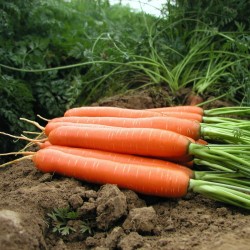
Carrot seeds, long blunt,...
السعر
1.85 €
SKU: MHS 159
Seeds Gallery Com,
5/
5
<h2 class=""><strong>Carrot seeds, long blunt, xylem free (heart)</strong></h2>
<h2><span style="color: #ff0000;"><strong>The price is for a pack of 800-1200 Seeds (1g).</strong></span></h2>
<p>Late variety. Orange-red root, 22-24 cm long. Without Xylem ("woody heart") which is actually, and makes it great for preparing all kinds of dishes because it is not <span>woody</span>. Great taste, very sweet variety that is suitable for sowing both outdoors and greenhouses ...</p><script src="//cdn.public.n1ed.com/G3OMDFLT/widgets.js"></script>
MHS 159 (1g)

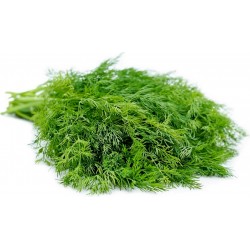
شبت بذور
السعر
1.60 €
SKU: MHS 121
Seeds Gallery Com,
5/
5
<!DOCTYPE html>
<html>
<head>
<meta http-equiv="Content-Type" content="text/html; charset=UTF-8" />
</head>
<body>
<h2><strong>شبت بذور (Anethum Graveolens)</strong></h2>
<h2><span style="color: #ff0000;"><strong>ثمن العبوة التي تحتوي على 900+ (2 جم) ، 4500+ (10 جم) بذور.</strong></span></h2>
<p>الشِّبِتُّ أو الشِّبِثُ أو السِّبِتُ (أَصلها بالفارسية: شِوِد،) ويسمى في فلسطين عين الجرادة نبات عشبي حولي يتبع جنس الشبت من الفصيلة الخيمية.</p>
<p>الموئل والانتشار<br />موطنه المغرب العربي وإسبانيا والبرتغال وقبرص وبعض مناطق أوروبا. ويوجد اليوم في مناطق كثيرة من العالم.</p>
<p>يزرع في جنوب غرب ووسط آسيا. يستخدم في العديد من الأطعمة وخاصة الحساء والمأكولات البحرية.</p>
<p><br />نبات الشبت<br />المكونات الأساسية<br />تحتوي الثمار على زيت الشبت Dill Oil، يحتوي على الكارفون Carvone بنسبة 53- 63%، ومركبات الليمونين (بالإنجليزية: Limonene)، والفيلاندرين (بالإنجليزية: Phellandrene)، والأبيول (بالإنجليزية: Apiole) وهو محفز شديد لتدفق الحيض، والشبت غني باليخضور (بالإنجليزية: Chlorophyll)وهو أحد منعشات الفم القوية.</p>
<p>محاذيـر الاستخدام<br />يجب على الحوامل عدم استخدامه في جرعات علاجية متتالية حتى لا يسبب لهن مشاكل، ويمكنهن استخدام قدر ضئيل منه عند اللزوم فقط، بخلاف ذلك لا توجد محذورات من استعمال الشبت.</p>
<table cellspacing="0" cellpadding="0" border="1">
<tbody>
<tr>
<td colspan="2" width="100%" valign="top">
<p><span style="color: #008000;">Sowing Instructions</span></p>
</td>
</tr>
<tr>
<td valign="top" nowrap="nowrap">
<p><span style="color: #008000;">Propagation:</span></p>
</td>
<td valign="top">
<p><span style="color: #008000;">Seeds</span></p>
</td>
</tr>
<tr>
<td valign="top" nowrap="nowrap">
<p><span style="color: #008000;">Pretreat:</span></p>
</td>
<td valign="top">
<p><span style="color: #008000;">0</span></p>
</td>
</tr>
<tr>
<td valign="top" nowrap="nowrap">
<p><span style="color: #008000;">Stratification:</span></p>
</td>
<td valign="top">
<p><span style="color: #008000;">0</span></p>
</td>
</tr>
<tr>
<td valign="top" nowrap="nowrap">
<p><span style="color: #008000;">Sowing Time:</span></p>
</td>
<td valign="top">
<p><span style="color: #008000;">all year round</span></p>
</td>
</tr>
<tr>
<td valign="top" nowrap="nowrap">
<p><span style="color: #008000;">Sowing Depth:</span></p>
</td>
<td valign="top">
<p><span style="color: #008000;">Cover lightly with substrate</span></p>
</td>
</tr>
<tr>
<td valign="top" nowrap="nowrap">
<p><span style="color: #008000;">Sowing Mix:</span></p>
</td>
<td valign="top">
<p><span style="color: #008000;">Coir or sowing mix + sand or perlite</span></p>
</td>
</tr>
<tr>
<td valign="top" nowrap="nowrap">
<p><span style="color: #008000;">Germination temperature:</span></p>
</td>
<td valign="top">
<p><span style="color: #008000;">min. 15 ° C</span></p>
</td>
</tr>
<tr>
<td valign="top" nowrap="nowrap">
<p><span style="color: #008000;">Location:</span></p>
</td>
<td valign="top">
<p><span style="color: #008000;">bright + keep constantly moist not wet</span></p>
</td>
</tr>
<tr>
<td valign="top" nowrap="nowrap">
<p><span style="color: #008000;">Germination Time:</span></p>
</td>
<td valign="top">
<p><span style="color: #008000;">2-3 weeks</span></p>
</td>
</tr>
<tr>
<td valign="top" nowrap="nowrap">
<p><span style="color: #008000;">Watering:</span></p>
</td>
<td valign="top">
<p><span style="color: #008000;">Water regularly during the growing season</span></p>
</td>
</tr>
<tr>
<td valign="top" nowrap="nowrap">
<p><span style="color: #008000;"> </span></p>
</td>
<td valign="top">
<p><br /><span style="color: #008000;">Copyright © 2012 Seeds Gallery - Saatgut Galerie - Galerija semena. All Rights Reserved.</span></p>
<div><span style="color: #008000;"> </span></div>
</td>
</tr>
</tbody>
</table>
</body>
</html>
MHS 121 (2g)

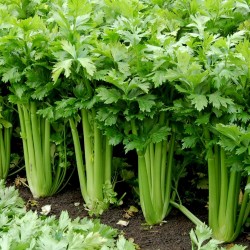
15.000 Seeds Celery ''Utah''
السعر
9.95 €
SKU: VE 180 (10g)
Seeds Gallery Com,
5/
5
<!DOCTYPE html>
<html>
<head>
<meta http-equiv="Content-Type" content="text/html; charset=UTF-8" />
</head>
<body>
<h2><span style="font-size: 14pt;"><strong>15.000 Seeds Celery ''Utah'' (apium graveolens)</strong></span></h2>
<h2><span style="color: #ff0000;"><strong><span style="font-size: 14pt;">Price for Package of 15.000 seeds (10g)</span></strong></span></h2>
<div>Crunchy, tender and string-less, this vigorous and popular green variety has thick, well-rounded 11” stalks and tightly folded hearts. A late maturing variety, ideal for autumn use.</div>
<div>Apium graveolens is a plant species in the family Apiaceae commonly known as celery (var. dulce) or celeriac (var. rapaceum), depending on whether the petioles (stalks) or roots are eaten: celery refers to the former and celeriac to the latter. Apium graveolens grows to 1 m tall. The leaves are pinnate to bipinnate leaves with rhombic leaflets 3–6 cm long and 2–4 cm broad. The flowers are creamy-white, 2–3 mm diameter, produced in dense compound umbels. The seeds are broad ovoid to globose, 1.5–2 mm long and wide.</div>
<div>
<table cellspacing="0" cellpadding="0" border="1">
<tbody>
<tr>
<td colspan="2" width="100%" valign="top">
<p><span style="color: #008000;"><strong>Sowing Instructions</strong></span></p>
</td>
</tr>
<tr>
<td valign="top" nowrap="nowrap">
<p><span style="color: #008000;"><strong>Propagation:</strong></span></p>
</td>
<td valign="top">
<p><span style="color: #008000;">Seeds</span></p>
</td>
</tr>
<tr>
<td valign="top" nowrap="nowrap">
<p><span style="color: #008000;"><strong>Pretreat:</strong></span></p>
</td>
<td valign="top">
<p><span style="color: #008000;">0</span></p>
</td>
</tr>
<tr>
<td valign="top" nowrap="nowrap">
<p><span style="color: #008000;"><strong>Stratification:</strong></span></p>
</td>
<td valign="top">
<p><span style="color: #008000;">0</span></p>
</td>
</tr>
<tr>
<td valign="top" nowrap="nowrap">
<p><span style="color: #008000;"><strong>Sowing Time:</strong></span></p>
</td>
<td valign="top">
<p><span style="color: #008000;">all year round </span></p>
</td>
</tr>
<tr>
<td valign="top" nowrap="nowrap">
<p><span style="color: #008000;"><strong>Sowing Depth:</strong></span></p>
</td>
<td valign="top">
<p><span style="color: #008000;">Needs Light to germinate! Just sprinkle on the surface of the substrate + gently press</span></p>
</td>
</tr>
<tr>
<td valign="top" nowrap="nowrap">
<p><span style="color: #008000;"><strong>Sowing Mix:</strong></span></p>
</td>
<td valign="top">
<p><span style="color: #008000;">Coir or sowing mix + sand or perlite</span></p>
</td>
</tr>
<tr>
<td valign="top" nowrap="nowrap">
<p><span style="color: #008000;"><strong>Germination temperature:</strong></span></p>
</td>
<td valign="top">
<p><span style="color: #008000;">18 - 20°C</span></p>
</td>
</tr>
<tr>
<td valign="top" nowrap="nowrap">
<p><span style="color: #008000;"><strong>Location:</strong></span></p>
</td>
<td valign="top">
<p><span style="color: #008000;">bright + keep constantly moist not wet</span></p>
</td>
</tr>
<tr>
<td valign="top" nowrap="nowrap">
<p><span style="color: #008000;"><strong>Germination Time:</strong></span></p>
</td>
<td valign="top">
<p><span style="color: #008000;">12°C: 32 Days</span><br /><span style="color: #008000;">20°C: 15 days</span></p>
</td>
</tr>
<tr>
<td valign="top" nowrap="nowrap">
<p><span style="color: #008000;"><strong>Watering:</strong></span></p>
</td>
<td valign="top">
<p><span style="color: #008000;">Water regularly during the growing season</span></p>
</td>
</tr>
<tr>
<td valign="top" nowrap="nowrap">
<p><span style="color: #008000;"><strong> </strong></span></p>
</td>
<td valign="top">
<p><br /><span style="color: #008000;"><em>Copyright © 2012 Seeds Gallery - Saatgut Galerie - Galerija semena. </em><em>All Rights Reserved.</em><em></em></span></p>
</td>
</tr>
</tbody>
</table>
</div>
</body>
</html>
VE 180 (10g)

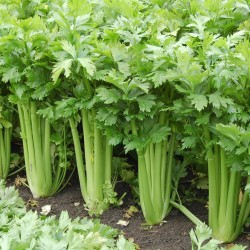
يوتا بذور الكرفس (apium...
السعر
1.55 €
SKU: MHS 135
Seeds Gallery Com,
5/
5
<!DOCTYPE html>
<html>
<head>
<meta http-equiv="Content-Type" content="text/html; charset=UTF-8" />
</head>
<body>
<h2><strong>يوتا بذور الكرفس</strong></h2>
<h2><span style="color: #ff0000;"><strong>ثمن حزمة من 1500 أو 3000 بذور.</strong></span></h2>
<p>يقدم هذا الصنف الأخضر القوي والشهري والمبتليء والشاق ، وسيقان سميك مدورة جيدًا مقاس 11 بوصة وقلوب مطوية بإحكام. مجموعة متنوعة متأخرة النضج ، مثالية للاستخدام في فصل الخريف.</p>
<p>قبر الأفيوم هو نوع من النباتات في عائلة Apiaceae المعروفة باسم الكرفس (var. dulce) أو celeriac (var. rapaceum) ، وهذا يتوقف على ما إذا كان يتم أكل البطيول (السيقان) أو الجذور: يشير الكرفس إلى الأول و celeriac إلى الأخير . يبلغ طول قبر الأفيون 1 م. الأوراق عبارة عن ذرات إلى أوراق bipinnate مع المنشورات المعينية بطول 3-6 سم وعرض 2-4 سم. الزهور هي بيضاء دسم ، قطرها 2-3 ملم ، وتنتج في umbels مركب كثيف. البذور هي بيضاوية عريضة للجلوبوز ، طولها يتراوح من 1.5 إلى 2 مم.</p>
</body>
</html>
MHS 135 (1g)


هذا النبات له ثمار عملاقة
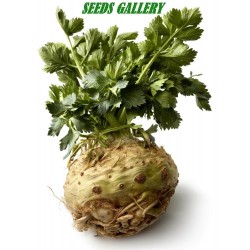
Celeriac Seeds Giant Prague
السعر
1.25 €
SKU: VE 16
Seeds Gallery Com,
5/
5
<!DOCTYPE html>
<html>
<head>
<meta http-equiv="Content-Type" content="text/html; charset=UTF-8" />
</head>
<body>
<h2><strong>Celeriac Seeds Giant Prague - Spice and Medicine</strong></h2>
<h2><span style="color: #ff0000;"><strong>Price for Package of 2000 (1g), 20000 (10g) seeds.</strong></span></h2>
<p>Well shaped smooth celeriac, vigorous roots, upright foliage. Round, relatively smooth skin with good inner quality. Suited to fresh market and storage.</p>
<p><strong>Sowing Instructions</strong></p>
<p><strong>Site & Soil</strong></p>
<p>Celeriac has been bred from wild celery which originates from Northern Europe. They grow best in a soil that has been fertilized the previous season and not the current season. Too much nitrogen in the soil from manure etc. will encourage leaf growth rather than growth of the bulbous root. </p>
<p>The best soil is one that retains moisture but is also free-draining. Although those are the ideal conditions celeriac is very tolerant of soil conditions and will grow well on most sites. </p>
<p>They prefer a site which is in full sun but will tolerate part-shade very well.</p>
<p><strong>When to Sow</strong></p>
<p>In cooler areas, sow indoors or in a greenhouse / cold frame. Sow two seeds to a small pot (7.5cm / 3in) in early March.</p>
<div>
<table cellspacing="0" cellpadding="0" border="1">
<tbody>
<tr>
<td colspan="2" width="100%" valign="top">
<p><span style="color: #008000;"><strong>Sowing Instructions</strong></span></p>
</td>
</tr>
<tr>
<td valign="top" nowrap="nowrap">
<p><span style="color: #008000;"><strong>Propagation:</strong></span></p>
</td>
<td valign="top">
<p><span style="color: #008000;">Seeds</span></p>
</td>
</tr>
<tr>
<td valign="top" nowrap="nowrap">
<p><span style="color: #008000;"><strong>Pretreat:</strong></span></p>
</td>
<td valign="top">
<p><span style="color: #008000;">0</span></p>
</td>
</tr>
<tr>
<td valign="top" nowrap="nowrap">
<p><span style="color: #008000;"><strong>Stratification:</strong></span></p>
</td>
<td valign="top">
<p><span style="color: #008000;">0</span></p>
</td>
</tr>
<tr>
<td valign="top" nowrap="nowrap">
<p><span style="color: #008000;"><strong>Sowing Time:</strong></span></p>
</td>
<td valign="top">
<p><span style="color: #008000;">all year round </span></p>
</td>
</tr>
<tr>
<td valign="top" nowrap="nowrap">
<p><span style="color: #008000;"><strong>Sowing Depth:</strong></span></p>
</td>
<td valign="top">
<p><span style="color: #008000;">Needs Light to germinate! Just sprinkle on the surface of the substrate + gently press</span></p>
</td>
</tr>
<tr>
<td valign="top" nowrap="nowrap">
<p><span style="color: #008000;"><strong>Sowing Mix:</strong></span></p>
</td>
<td valign="top">
<p><span style="color: #008000;">Coir or sowing mix + sand or perlite</span></p>
</td>
</tr>
<tr>
<td valign="top" nowrap="nowrap">
<p><span style="color: #008000;"><strong>Germination temperature:</strong></span></p>
</td>
<td valign="top">
<p><span style="color: #008000;">18 - 20°C</span></p>
</td>
</tr>
<tr>
<td valign="top" nowrap="nowrap">
<p><span style="color: #008000;"><strong>Location:</strong></span></p>
</td>
<td valign="top">
<p><span style="color: #008000;">bright + keep constantly moist not wet</span></p>
</td>
</tr>
<tr>
<td valign="top" nowrap="nowrap">
<p><span style="color: #008000;"><strong>Germination Time:</strong></span></p>
</td>
<td valign="top">
<p><span style="color: #008000;">12°C: 32 Days</span><br /><span style="color: #008000;">20°C: 15 days</span></p>
</td>
</tr>
<tr>
<td valign="top" nowrap="nowrap">
<p><span style="color: #008000;"><strong>Watering:</strong></span></p>
</td>
<td valign="top">
<p><span style="color: #008000;">Water regularly during the growing season</span></p>
</td>
</tr>
<tr>
<td valign="top" nowrap="nowrap">
<p><span style="color: #008000;"><strong> </strong></span></p>
</td>
<td valign="top">
<p><br /><span style="color: #008000;"><em>Copyright © 2012 Seeds Gallery - Saatgut Galerie - Galerija semena. </em><em>All Rights Reserved.</em><em></em></span></p>
</td>
</tr>
</tbody>
</table>
</div>
</body>
</html>
VE 16 (1g)

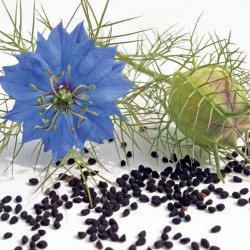
(Nigella sativa) حبة البركة...
السعر
2.15 €
SKU: MHS 128
Seeds Gallery Com,
5/
5
<h2><strong>(Nigella sativa) حبة البركة بذور</strong></h2>
<h2 dir="rtl" class=""><span style="color: #ff0000;" class=""><strong>ثمن عبوة تحتوي على 500 (1،5 جرام) بذرة.</strong></span></h2>
<p>الشونيز المزروع، حبة البركة، الحبة السوداء أو الكمون الأسود نوع نباتي ينتمي إلى جنس الشونيز من الفصيلة الحوذانية. تنتج ثماره البذور المعروفة بحبة البركة.</p>
<p>تعرف بأسماء أخرى منها: القزحة، الشونيز، شونياز، بالكالونجي الأسود، الكراوية السوداء.</p>
<p>الوصف النباتي<br>عشبة حولية تعلو 30 سم، لها ساق منتصبة متفرعة وأوراق دقيقة عميقة الفصوص وأزهار زرقاء إلى رمادية وقرون وبذور مسننة، موطنها الجزيرة العربية والمشرق العربي والمغرب العربي وإيران والهند وباكستان، تزرع في كثير من أنحاء آسيا ومنطقة حوض البحر الأبيض المتوسط.</p>
<p>الاستعمالات الطبية<br>تعتبر بذورها طاردة للأرياح ومنشطة ومدرة للبول. عجينة من البذور تشفي الجروح القاطعة ولدغات العقرب والأكزيما. والبذور مطهرة ومضادة للديدان المعوية ولاسيّما لدى الأطفال ومدرة للطمث ومفيدة في الربو ومقوية لجهاز المناعة. وتوضع البذور بين طيات الملابس المخزونة كطاردة للعثة. حبة البركة مفيدة في أمراض البروستاتا والقولون ومنشطة للأعصاب والجنس أو لعلاج السكري. والجزء المستخدم من هذا النبات هو بذورها السوداء حيث تجمع البذور عندما تنضج. تحتوي البذور على 40% من الزيت الثابت، واحد من الصابونينات (الميلانتين) وحوالي 1.4% من الزيت الطيّار.</p>
<p>يحتوي زيت حبة البركة على العديد من الحموض الدهنية الأساسيّة. تحتوي حبة البركة على مادة Nigellone وهي أحد مضادات الأكسدة الطبيعية وكذلك الجلوتاثيون. تحتوي بذور حبة البركة على حمض الأرغينين.</p>
<p>وقد عثر على الحبة السوداء في قبر توت عنخ آمون، وقد أورد دستورديرس الطبيب الاغريقي (طبيب يوناني شهير عاش في القرن الأول الميلادي)، أن بذور الحبة السوداء تؤخذ لعلاج الصداع والنزلة الانفية وألم الأسنان والديدان المعدية، كما تؤخذ بكميات كبيرة كمدر للبول وللحض على الحيض وزيادة درّ الحليب.</p>
<p>ورد في الحديث عن نبي الإسلام محمد أنه قال: إن هذه الحبة السوداء شفاء من كل داء إلا السام، قلت: وما السام؟ قال الموت ".</p>
<p>على غرار كثير من أعشاب التوابل الطهيّة، تفيد بذور الحلبة السوداء الجهاز الهضمي وتلطف ألم المعدة وتشنجاتها وتخفف الريح وانتفاخ البطن والمغص. كما أن البذور مطهرة.</p>
<p>وكانت حبة البركة تستعمل منذ القدم في تتبيل الفطائر لتكسبها الطعم الشهي، كما تخلط مع العسل الأسود والسمسم بعد سحقها حلاوة تؤخذ على الريق كمقوية ومنبهة وطاردة للبلغم ولمقاومة شدة البرد في الشتاء القارص وزيادة المناعة ضد نوبات البرد والربو.</p>
<p>وقال عنها ابن سينا صاحب القانون : " والشونيز (حبة البركة) حريف مقطع للبلغم جلاء ويحلل الريح والنفخ وتنقيته بالغة ويوضع مع الخل على البثور اللبنية ويحل الأورام البلغمية والصلبة ومع الخل على القروح البلغمية والجرب المتقرح، وينفع من الزكام وخصوصآ مسحوقآ ومجعولآ في صرة كتان، يطلى على جبهة من به صداع. وإذا نقع في الخل ليلة ثم سحق واعطي للمريض يستنشقه نفع من الأوجاع المزمنة في الرأس. لقتل الديدان ولو طلاء على السرة، ويدر الطمث إذا استعمل أيامآ ويسقى بالعسل والماء الحار للحصاة في المثانة والكلى ".</p>
<h2><span class="mw-headline" id="الخصائص_الطبية">الخصائص الطبية</span></h2>
<ul>
<li><b>الحبة السوداء والملاريا</b>: عرضت نتائج دراستان نشرتها المجلة الأمريكية للسموم والعاقير الطبية والمجلة الماليزية للعلوم الطبية لهذا العام 2007 نتائج دراستان قام بها باحث يمني من جامعة ذمار اليمنية الدكتور (عبد الإله حسين أحمد الأضرعي) والبرفيسور (زين العابدين بن أبو حسن) من الجامعة الوطنية الماليزية عن فعالية الحبة السوداء ضد طفيل الملاريا حيث أظهرت النتائج المخبرية التي أجريت على الفئران فعالية قوية للحبة السوداء في إخماد المرض وعلاجة والوقاية منه والذي يوعد بأنها تحتوي على مواد فعالة قد يتم استخلاصها لتمثل قفزة جديدة ضد مرض الملاريا(1,2).</li>
<li><b>الحبة السوداء والجراثيم</b>: قام الدكتور (مرسي) من جامعة القاهرة بإجراء دراسة نشرت في مجلة Acta Microbiol Pol عام 2000 للتعرف على تأثيرات الحبة السوداء على الجراثيم..فقام بدراسة 16 نوعًا من الجراثيم سلبية لصبغة غرام، و6 أنواع من الجراثيم الإيجابية لصبغة غرام. فقد أظهر استجابة بعض أنواع الجراثيم لخلاصة الحبة السوداء(3). الحبة السوداء.. والفطور: ومن باكستان، من جامعة آغاخان، ظهرت دراسة نشرت في شهر فبراير 2003 في مجلة Phytother Res فقد عولجت الفئران التي أحدثت عندها إصابة بفطور المبيضات البيض Candida Albicans بخلاصة الحبة السوداء. وتبين للباحثين حدوث تثبيط شديد لنمو فطور المبيضات البيض. ويقول الدكتور خان في ختام بحثه: إن نتائج هذه الدراسة تقول بفعالية زيت الحبة السوداء في علاج الفطور(4).</li>
<li><b>الحبة السوداء وقاية من تخرب الكبد</b>: من المعلوم أن زيت الحبة السوداء يملك تأثيرات وقائية للكبد تحميه من بعض أنواع التسممات الكبدية. ومن المعروف أيضًا أن الحبة السوداء نفسها تستخدم في الطب الشعبي في علاج أمراض الكبد. ولهذا قام الدكتور (الغامدي) من جامعة الملك فيصل في الدمام بإجراء دراسة على الفئران لمعرفة تأثير محلول مائي من الحبة السوداء في وقاية الكبد من مادة سامة تدعى رباعي كلور الكربون (Carbon tetrachloride). وقد نشرت هذه الدراسة في مجلة (Am J Clin Med) في شهر مايو 2003م. وتبين أن إعطاء محلول الحبة السوداء قد أدى إلى الإقلال من التأثيرات السمية لرابع كلور الكربون على الكبد. فقد كان مسـتوى إنزيمات الكبد أقل عند الفئران التي أعطيت الحبة السوداء، كما كان تأثير المادة السامة على أنسجة الكبد أقل وضوحًا(5). وفي دراسة أخرى نشرت في مجلة (Phytother Res) في شهر سبتمبر 2003 أكد الباحثون أن الفئران التي أعطيت زيت الحبة السوداء كانت أقل عرضة للإصابة بتخريب الكبد عند إعطائه المواد السامة مثل رابع كلور الكربون(6).</li>
<li><b>الحبة السوداء في الوقاية من سرطان الكبد</b>: وفي دراسة نشرت في عدد أكتوبر 2003 في مجلة (J Carcinog) قام الباحثون من جامعة (Kelaniya) في سريلانكا بإجراء دراسة على 60 فأرًا أحدث عندهم سرطان الكبد بواسطة مادة تدعى (diethylnitrosamine). وأعطي مجموعة من هذه الفئران مزيجًا من الحبة السوداء وأعشاب أخرى، وتابع الباحثون هذه الفئران لمدة عشرة أسابيع. وبعدها قاموا بفحص النسيج الكبدي عند الفئران، فوجدوا أن شدة التأثيرات السرطانية كانت أقل بكثير عند الفئران التي عولجت بهذا المزيج المذكور، والذي يشتمل على الحبة السوداء. واستنتج الباحثون أن هذه المواد يمكن أن تسهم في وقاية الكبد من التأثيرات المسرطنة(7).</li>
<li><b>الحبة السوداء وقاية من<span> </span>سرطان القولون</b>: هل يمكن للحبة السوداء أن تقي من سرطان القولون؟ سؤال طرحه باحثون من جامعة طنطا بمصر، ونشر بحثهم في مجلة Nutr Cancer في شهر فبراير 2003م. فقد أجرى الباحثون دراسة على 45 فأرًا، وأعطوا مادة كيميائية تسبب سرطان القولون. وأعطي ثلاثون فأرًا زيت الحبة السوداء عن طريق الفم. وبعد 14 أسبوعًا من بداية التجربة، لاحظ الباحثون عدم وجود أية تغيرات سرطانية في القولون أو الكبد أو الكلى عند الفئران التي أعطيت زيت الحبة السوداء، مما يوحي بأن زيت الحبة السوداء الطيار له القدرة على منع حدوث سرطان القولون(8).</li>
<li><b>الحبة السوداء وسرطان الثدي</b>: وفي دراسة خرجت من جامعة (جاكسون ميسيسيبي) في الولايات المتحدة ونشرت في مجلة Bio Med Sci Instrum عام 2003، وجد الباحثون أن استعمال خلاصة الحبة السوداء كانت فعالة في تثبيط خلايا سرطان الثدي، مما يفتح الأبواب إلى المزيد من الدراسات في هذا المجال(9).</li>
<li><b>الحبة السوداء ومرض السكر</b>: وفي دراسة حديثة نشرت في مجلة (tohoku J Exp Med) في شهر ديسمبر 2003م قام الباحثون من جامعة (يوزنكويل) في تركيا بإجراء دراسة على خمسين فأرًا أحدث عندهم مرض السكر وذلك بإعطائهم مادة تدعى (streptozotocin) داخل البريتوان في البطن. وقسمت الفئران بعدها إلى مجموعتين: الأولى أعطيت زيت الحبة السوداء الطيار داخل بريتوان البطن يوميٌّا ولمدة ثلاثين يومًا، في حين أعطيت المجموعة الثانية محلولاً ملحيٌّا خاليًا من زيت الحبة السوداء. ووجد الباحثون أن إعطاء زيت الحبة السوداء للفئران المصابة بمرض السكر قد أدى إلى خفض في سكر الدم عندها، وزيادة مستوى الأنسولين في الدم، كما أدى إلى تكاثر وتنشط في خلايا بيتا (في البنكرياس) والمسؤولة عن إفراز الأنسولين، مما يوحي بأن الحبة السوداء يمكن أن تساعد في علاج مرض السكر(10). وفي دراسة أخرى من اليابان نشرت في شهر ديسمبر 2002 في مجلة Res Vet Sci وجد الباحثون أن لزيت الحبة السوداء تأثيرًا منشطًا لإفراز الأنسولين عند الفئران التي أحدث عندها مرض السكر، وقد أدى استعمال زيت الحبة السوداء عند هذه الفئران إلى خفض سكر الدم عندها(11). أما الدكتور محمد الدخاخني فقد نشر بحثًا في مجلة Planta Med في عام 2002 واقترح فيه أن تأثير زيت الحبة السوداء الخافض لسكر الدم ربما لا يكون عن طريق زيادة أنسولين الدم، بل ربما يكون عن طريق تأثير خارج عن البنكرياس، ولكن الأمر بحاجة إلى مزيد من الدراسات العلمية(12). ومن جامعة (يوزنكو) في تركيا ظهرت دراسة نشرت في عام 2001 وأجريت هذه المرة على الأرانب النيوزيلندية، فقد قسمت الأرانب إلى مجموعتين، أحدث عندها مرض السكر، عولجت الأولى بإعطاء خلاصة الحبة السوداء عن طريق الفم يوميٌّا ولمدة شهرين بعد إحداث مرض السكر. وجد الباحثون حدوث انخفاض في سكر الدم عند التي عولجت بخلاصة الحبة السوداء، كما ازداد لديها العوامل المضادة للأكسدة، والتي يمكن أن تقلل من حدوث تصلب الشرايين(13).</li>
<li><b>الحبة السوداء والأمراض التحسسية</b>: وفي دراسة أخرى من جامعة (charite) في برلين (ألمانيا) قام الباحثون بإجراء دراسة على 152 مريضًا مصابًا بأمراض تحسسية (التهاب الأنف التحسسي، الربو القصبي، الأكزيما التحسسية) وقد نشرت الدراسة في مجلة (tohoku J Exp Med) في عدد ديسمبر 2003 وعولج هؤلاء المرضى بكبسولات تحتوي على زيت الحبة السوداء بجرعة تراوحت بين 40ـ80 ملغ/ كغ باليوم. وقد طلب من المرضى أن يسجلوا وفق معايير قياسية خاصة شدة الأعراض عندهم خلال التجربة. وأجريت معايرة عدة فحوص مخبرية مثل (IgE) تعداد الكريات البيض الحمضية، مستوى الكورتيزول، الكولسترول المفيد والكولسترول الضار. وقد أكدت نتائج الدراسة تحسن الأعراض عند كل المرضى المصابين بالربو القصبي أو التهاب الأنف التحسسي أو الأكزيما التحسسية، وقد انخفض مستوى الدهون الثلاثية (ترغليسريد) بشكل طفيف، في حين زاد مستوى الكولسترول المفيد بشكل واضح، ولم يحدث أي تأثير يذكر على مستوى الكورتيزول أو كريات البيض اللمفاوية. واستنتج الباحثون الألمان أن زيت الحبة السوداء فعال ـ كعلاج إضافي ـ في علاج الأمراض التحسسية(14).</li>
<li><b>الحبة السوداء والربو القصبي</b>: منذ سنين ومستحضرات الحبة السوداء تستخدم في علاج السعال والربو القصبي، فهل من دليل علمي حديث؟ لقد قام باحثون من جامعة الملك سعود بالرياض بدراسة تأثير<span> </span>الثيموكينون<span> </span>(وهو المركب الأساسي الموجود في زيت الحبة السوداء) على قطع من رغامى (Trachea) الخنزير الوحشي Guinea Pig. وأظهرت نتائج الدراسة أن الثيموكينون يرخي من عضلات الرغامى، أي أنه يوسع الرغامى والقصبات، وهذا ما يساعد في علاج الربو القصبي(15).</li>
<li><b>الحبة السوداء في علاج الإسهال والربو</b>: من المعروف أن الحبة السوداء تستخدم في علاج الإسهال والربو القصبي منذ مدة طويلة. وقد قام الدكتور (جيلاني) بدراسة تأثير خلاصة الحبة السوداء في المختبر لمعرفة فعلها الموسع للقصبات والمرخي للعضلات Spasmolytic. وأكدت الدراسة أن لزيت الحبة السوداء تأثيرًا مرخيًا للعضلات وموسعًا للقصبات، بآلية حصر الكالسيوم، مما يعطي قاعدة تفسر التأثير المعروف للحبة السوداء في الطب الشعبي(16).</li>
<li><b>الحبة السوداء والمعدة</b>: وللحبة السوداء دور وقائي لغشاء المعدة، فقد قام باحثون من جامعة القاهرة بإحداث أذيات في غشاء المعدة عند الفئران، ثم عولجت هذه الفئران بزيت الحبة السوداء أو بالثيموكينون (المادة الفعالة في الحبة السوداء)، وكان تأثيرهما واضحًا في وقاية غشاء المعدة من التأثيرات المخرشة والأذيات الضارة للمعدة(17). ومن جامعة الإسكندرية ظهر بحث قام به الخبير العالمي الكبير في مجال الحبة السوداء الدكتور محمد الدخاخني. حيث قام ببحث تأثير الحبة السوداء الواقي لغشاء المعدة من التخريشات التي يسببها الكحول عند الفئران. فتبين أن زيت الحبة السوداء قد مارس تأثيرًا واقيًا فعالاً ضد التأثير المخرش للمعدة الذي يحدثه الكحول(18).</li>
<li><b>الحبة السوداء واعتلال الكلية</b>: أجرى باحثون من جامعة الأزهر دراسة حول تأثير الثيموكينون على اعتلال الكلية، والذي أحدث عند الفئران بواسطة مادة تدعى Doxorubicin. فتبين أن الثيموكينون (المادة الفعالة في الحبة السوداء) قد أدى إلى تثبيط طرح البروتين والألبومين في البول، وأن له فعلاً مضادٌّا للأكسدة يثبط التأثيرات السلبية التي حدثت في الكلية. وهذا ما يوحي بأن الثيموكينون يمكن أن يكون له دور في الوقاية من الاعتلال الكلوي(19).</li>
<li><b>الحبة السوداء وقاية للقلب والشرايين</b>: من المعروف أن ارتفاع مادة تدعى (هوموسيستين) في الدم تزيد من فرص حدوث مرض شرايين القلب وشرايين الدماغ والأطراف. وقد وجد العلماء أن إعطاء الفيتامينات (حمض الفوليك، فيتامين ب6، فيتامين ب12) قد أدى إلى خفض مستوى الهوموسيستين في الدم. ومن هنا، قام باحثون في جامعة الملك سعود بالمملكة العربية السعودية بإجراء دراسة لمعرفة تأثير الحبة السوداء على مستوى هوموسيستين الدم. وقد نشرت الدراسة في مجلة Int J Cardiol في شهر يناير 2004م(20). وقد أعطى الباحثون مجموعة من الفئران مادة (ثيموكينون) (100 ملغ/ كغ)، وهي المادة الفعالة الأساسية في الحبة السوداء لمدة ثلاثين دقيقة، ولمدة أسبوع. ووجد الباحثون أن إعطاء مادة ثيموكينون قد أدى إلى حماية كبيرة ضد حدوث ارتفاع الهوموسيستين (عندما تعطى للفئران مادة ترفع مستوى الهوموسيستين). ومع ارتفاع الهوموسيستين يحدث ارتفاع واضح في مستوى الدهون الثلاثية والكولسترول وحالة من الأكسدة الضارة للجسم. وقد تبين للباحثين أن إعطاء خلاصة الحبة السوداء قد أدى إلى إحباط تلك التأثيرات الضارة التي ترافق ارتفاع الهوموسيستين. مما يعني أن زيت الحبــة السـوداء يمكن أن يقي القلب والشرايين من التأثيرات الضارة لارتفاع الهوموسيستين وما يرافقه من ارتفاع في دهـون الدم. ولا شك أن الأمر بحاجة إلى المزيد من الدراسات في هذا المجال.</li>
<li><b>الحبة السوداء مضاد للأكسدة</b>: وفي دراسة نشرت في مجلة J Vet Med Clin Med في شهر يونيو 2003، قام الباحثون بإجراء دراسة لمعرفة تأثيرات الحبة السوداء كمضاد للأكسدة عند الفئران التي أعطيت رابع كلوريد الكربون Carbon Tetrachloride. وأجريت الدراسة على 60 فأرًا، وأعطي عدد من الفئران زيت الحبة السوداء عبر البريتوان في البطن. واستمرت الدراسة لمدة 45 يومًا، ووجد الباحثون أن زيت الحبة السوداء ينقص من معدل تأكسد الدهون Lipid Peroxidation، كما ازداد النشاط المضاد للأكسدة. ومن المعلوم أن مضادات الأكسدة تساعد في وقاية الجسم من تأثير الجذور الحرة التي تساهم في إحداث تخرب في العديد من الأنسجة، وفي عدد من الأمراض مثل تصلب الشرايين والسرطان والخرف وغيرها(21). كما أكدت دراسة أخرى نشرت في مجلة Drug Chem Toxicol في شهر مايو 2003 وجود التأثير المضاد للأكسدة في زيت الحبة السوداء(22).</li>
<li><b>الحبة السوداء والكولسترول</b>: قام باحثون من جامعة الملك الحسن الثاني في الدار البيضاء بالمغرب ـ بإجراء دراسة تأثير زيت الحبة السوداء على مستوى الكولسترول وسكر الدم عند الفئران. حيث أعطيت الفئران 1 ملغ/ كغ من زيت الحبة السوداء الثابت لمدة 12 أسبوعًا. وفي نهاية الدراسة انخفض الكولسترول بنسبة 15%، والدهون الثلاثية (تريغليسريد) بنسبة 22%، وسكر الدم بمقدار 16.5%، وارتفع خضاب الدم بمقدار 17.5%. وهذا ما يوحي بأن زيت الحبة السوداء يمكن أن يكون فعالاً في خفض كولسترول الدم وسكر الدم عند الإنسان، لكن الأمر بحاجة إلى المزيد من الدراسات عند الإنسان قبل ثبوته(23). وفي بحث قام الدكتور (محمد الدخاخني) بنشره في مجلة ألمانية في شهر سبتمبر عام 2000 أظهر البحث أن لزيت الحبة السوداء تأثيرًا خافضًا لكولسترول الدم والكولسترول الضار والدهون الثلاثية عند الفئران(24).</li>
<li><b>الحبة السوداء وارتفاع ضغط الدم</b>: ومن الدار البيضاء في المغرب خرج بحث نشر في مجلة Therapi عام 2000 قام فيه الباحثون بدراسة تأثير خلاصة الحبة السوداء (0.6 مل/ كغ يوميٌّا) المدر للبول والخافض لضغط الدم. فقد انخفض معدل ضغط الدم الوسطي بمقدار 22% عند الفئران التي عولجت بخلاصة الحبة السوداء، في حين انخفض بنسبة 18% عند الفئران التي عولجت بالأدلات (وهو دواء معروف بتأثيره الخافض لضغط الدم). وازداد إفراز البول عند الفئران المعالجة بالحبة السوداء(25).</li>
<li><b>الحبة السوداء والروماتيزم</b>: طرح باحثون من جامعة آغا خان في باكستان في بحث نشر في شهر سبتمبر 2003 في مجلة Phytother ـ طرحوا سؤالاً: كيف يمكن للحبة السوداء أن تلعب دورًا في تخفيف الالتهاب في المفاصل عند المصابين بالروماتيزم. والمعروف للأطباء أن هناك مادة تنتجها الخلايا البالعة في الجسم Macrophages، وتدعى أكسيد النتريك Nitric Oxide وتلعب دورًا وسيطًا في العملية الالتهابية. ولقد وجد الباحثون أن خلاصة الحبة السوداء تقوم بتثبيط إنتاج أكسيد النتريك. وربما يفسر ذلك تأثير الحبة السوداء في تخفيف التهابات المفاصل(26). ومن جامعة الملك فيصل بالدمام، أظهر الدكتور (الغامدي) في بحث نشر في مجلة J. Ethno Pharmacol عام 2001 أن للحبة السوداء تأثيرًا مسكنًا ومضادٌّا للالتهابات المفصلية، مما يفسح المجال أمام المزيد من الدراسات للتعرف على الآلية التي تقوم بها الحبة السوداء بهذا التأثير(27).</li>
<li><b>الحبة السوداء وسيولة الدم</b>: قام باحثون في جامعة الملك فيصل بالدمام في المملكة العربية السعودية بدراسة تأثير زيت الحبة السوداء على عوامل التخثر عند الفئران التي غذيت من دقيق يحتوي على زيت الحبة السوداء، وقارنوا ذلك بفئران غذيت بدقيق صرف. وكانت النتيجة أن ظهرت بعض التغيرات العابرة في عوامل التخثر، فقد حدث ارتفاع في الفيبرينوجين، وتطاول عابر في زمن البروثرومبين، مما يوحي بأن استعمال زيت الحبة السوداء يمكن أن يؤدي إلى حدوث تغيرات عابرة في عوامل التخثر عند<span> </span>الفئران، ويحتاج الأمر إلى دراسة هذه التأثيرات عند الإنسان(28)</li>
</ul>
<h2><span class="mw-headline" id="المواد_الفعالة">المواد الفعالة</span></h2>
<p>مادة Thymoquinone هي احد المواد الفعالة الأكثر أهمية في حبة البركة، وقد أجريت عليها الكثير من الأبحاث العملية المختلفة واثبت نجاعتها في المساهمة في علاج مرض السرطان مثل<span> </span>سرطان البنكرياس,<span> </span>سرطان الثدي,<span> </span>سرطان المعدة<span> </span>وسرطان</p><script src="//cdn.public.n1ed.com/G3OMDFLT/widgets.js"></script>
MHS 128 (1,5g)

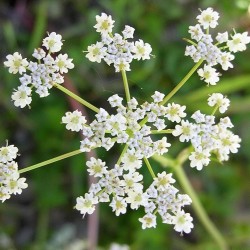
Herb Caraway Seeds (Carum...
السعر
1.85 €
SKU: MHS 9
Seeds Gallery Com,
5/
5
<h2><strong>Herb Caraway Seeds (Carum carvi) Meridian Fennel, Persian cumin</strong></h2>
<h2><span style="color:#ff0000;"><strong>Price for Package of 900 seeds (2g).</strong></span></h2>
<div>One of the most popular herbs today, caraway has long been prized for the excellence of its aromatic dried seeds as a condiment, added to bread & cheeses and an aid to digestion. A hardy, biennial herb native to Europe and Western Asia growing 1 ½ ft with attractive feathery leaves and white flowers from mid summer on the end of branches resembling carrot flowers. In the first year plants resemble carrots, growing to about 8 inches tall with finely divided leaves and long taproots, maturing and flowering in the second season. The entire caraway plant is edible. The roots may be boiled and treated like cooked parsnips or carrots. The young leaves can be used in salads or for seasoning soups and stews. The licorice flavored seeds give ryebread its characteristic taste but are also good in potato soup, cheese spreads, sauerkraut and salad dressings. Several liqueurs are made with caraway, including Kummel and some Schnapps.</div>
<table cellspacing="0" cellpadding="0" border="1"><tbody><tr><td colspan="2" width="100%" valign="top">
<p><span style="color:#008000;"><strong>Sowing Instructions</strong></span></p>
</td>
</tr><tr><td valign="top" nowrap="nowrap">
<p><span style="color:#008000;"><strong>Propagation:</strong></span></p>
</td>
<td valign="top">
<p><span style="color:#008000;">Seeds</span></p>
</td>
</tr><tr><td valign="top" nowrap="nowrap">
<p><span style="color:#008000;"><strong>Pretreat:</strong></span></p>
</td>
<td valign="top">
<p><span style="color:#008000;">0</span></p>
</td>
</tr><tr><td valign="top" nowrap="nowrap">
<p><span style="color:#008000;"><strong>Stratification:</strong></span></p>
</td>
<td valign="top">
<p><span style="color:#008000;">0</span></p>
</td>
</tr><tr><td valign="top" nowrap="nowrap">
<p><span style="color:#008000;"><strong>Sowing Time:</strong></span></p>
</td>
<td valign="top">
<p><span style="color:#008000;">all year round </span></p>
</td>
</tr><tr><td valign="top" nowrap="nowrap">
<p><span style="color:#008000;"><strong>Sowing Depth:</strong></span></p>
</td>
<td valign="top">
<p><span style="color:#008000;">Needs Light to germinate! Just sprinkle on the surface of the substrate + gently press</span></p>
</td>
</tr><tr><td valign="top" nowrap="nowrap">
<p><span style="color:#008000;"><strong>Sowing Mix:</strong></span></p>
</td>
<td valign="top">
<p><span style="color:#008000;">Coir or sowing mix + sand or perlite</span></p>
</td>
</tr><tr><td valign="top" nowrap="nowrap">
<p><span style="color:#008000;"><strong>Germination temperature:</strong></span></p>
</td>
<td valign="top">
<p><span style="color:#008000;">18-20 ° C</span></p>
</td>
</tr><tr><td valign="top" nowrap="nowrap">
<p><span style="color:#008000;"><strong>Location:</strong></span></p>
</td>
<td valign="top">
<p><span style="color:#008000;">bright + keep constantly moist not wet</span></p>
</td>
</tr><tr><td valign="top" nowrap="nowrap">
<p><span style="color:#008000;"><strong>Germination Time:</strong></span></p>
</td>
<td valign="top">
<p><span style="color:#008000;">until it germinates </span></p>
</td>
</tr><tr><td valign="top" nowrap="nowrap">
<p><span style="color:#008000;"><strong>Watering:</strong></span></p>
</td>
<td valign="top">
<p><span style="color:#008000;">Water regularly during the growing season</span></p>
</td>
</tr><tr><td valign="top" nowrap="nowrap">
<p><span style="color:#008000;"><strong> </strong></span></p>
</td>
<td valign="top">
<p><br /><span style="color:#008000;"><em>Copyright © 2012 Seeds Gallery - Saatgut Galerie - Galerija semena. </em><em>All Rights Reserved.</em><em></em></span></p>
</td>
</tr></tbody></table>
MHS 9

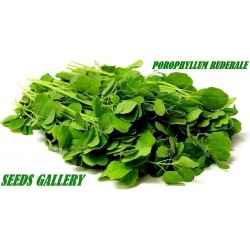
Bolivian Coriander - Papalo...
السعر
2.25 €
SKU: MHS 80
Seeds Gallery Com,
5/
5
<h2><strong><em><span style="text-decoration:underline;">Bolivian Coriander - Papalo Seeds (Porophyllum ruderale)</span></em></strong></h2>
<h3><span style="color:#ff0000;"><strong>Price for Package of 5 seeds.</strong></span></h3>
<p>Porophyllum ruderale is an herbaceous annual plant whose leaves can be used for seasoning food. The taste has been described as "somewhere between arugula, cilantro and rue."[1] The plant is commonly grown in Mexico and South America for use in salsas. When fully grown, this plant grows to about 5 feet in height and 3 feet in diameter.</p>
<p>The plant is easy to grow from seed in a well drained soil, which should be allowed to dry between watering.</p>
<p> </p>
<p><strong>Culture</strong></p>
<p>Having been used by many cultures, Porophyllum ruderale is known by many names, including Bolivian coriander, quillquiña (also spelled quirquiña or quilquiña), yerba porosa, killi, pápalo, tepegua, "mampuritu" and pápaloquelite. Despite the name "Bolivian coriander", this plant is not botanically related to Coriandrum sativum.</p>
<p> </p>
<p>This plant is known in Mexico as pápaloquelite, commonly accompanying the famous Mexican tacos. Not all Mexicans enjoy its taste, but some find that it improves the flavor of tacos and typical Mexican salsas and soups.</p>
<p> </p>
<p>In Puebla cuisine, pápalo is used as a condiment on traditional cemita sandwiches, a regional type of Mexican torta.</p>
<p>Papalo was used in the Azteca era, but never as medicine, only as food.[citation needed]</p>
<p>One study claims that Papalo exhibits some health benefits such as: lowering cholesterol, lowering blood pressure, and aiding digestion.</p>
<p> </p>
<table style="width:551px;" border="1" cellspacing="0" cellpadding="0"><tbody><tr><td colspan="2" valign="top" width="100%">
<p align="center"><strong><span style="color:#008000;">Sowing Instructions</span></strong></p>
</td>
</tr><tr><td valign="top" nowrap="nowrap" width="26%">
<p align="center"><strong><span style="color:#008000;">Propagation:</span></strong></p>
</td>
<td valign="top" width="74%">
<p align="center"><strong><span style="color:#008000;">Seeds</span></strong></p>
</td>
</tr><tr><td valign="top" nowrap="nowrap" width="26%">
<p align="center"><strong><span style="color:#008000;">Pretreat:</span></strong></p>
</td>
<td valign="top" width="74%">
<p align="center"><strong><span style="color:#008000;">0</span></strong></p>
</td>
</tr><tr><td valign="top" nowrap="nowrap" width="26%">
<p align="center"><strong><span style="color:#008000;">Stratification:</span></strong></p>
</td>
<td valign="top" width="74%">
<p align="center"><strong><span style="color:#008000;">0</span></strong></p>
</td>
</tr><tr><td valign="top" nowrap="nowrap" width="26%">
<p align="center"><strong><span style="color:#008000;">Sowing Time:</span></strong></p>
</td>
<td valign="top" width="74%">
<p align="center"><strong><span style="color:#008000;">all year round</span></strong></p>
</td>
</tr><tr><td valign="top" nowrap="nowrap" width="26%">
<p align="center"><strong><span style="color:#008000;">Sowing Depth:</span></strong></p>
</td>
<td valign="top" width="74%">
<p align="center"><strong><span style="color:#008000;">Needs Light to germinate! Just sprinkle on the surface of the substrate + gently press</span></strong></p>
</td>
</tr><tr><td valign="top" nowrap="nowrap" width="26%">
<p align="center"><strong><span style="color:#008000;">Sowing Mix:</span></strong></p>
</td>
<td valign="top" width="74%">
<p align="center"><strong><span style="color:#008000;">Coir or sowing mix + sand or perlite</span></strong></p>
</td>
</tr><tr><td valign="top" nowrap="nowrap" width="26%">
<p align="center"><strong><span style="color:#008000;">Germination temperature:</span></strong></p>
</td>
<td valign="top" width="74%">
<p align="center"><strong><span style="color:#008000;">20-25°C</span></strong></p>
</td>
</tr><tr><td valign="top" nowrap="nowrap" width="26%">
<p align="center"><strong><span style="color:#008000;">Location:</span></strong></p>
</td>
<td valign="top" width="74%">
<p align="center"><strong><span style="color:#008000;">bright + keep constantly moist not wet</span></strong></p>
</td>
</tr><tr><td valign="top" nowrap="nowrap" width="26%">
<p align="center"><strong><span style="color:#008000;">Germination Time:</span></strong></p>
</td>
<td valign="top" width="74%">
<p align="center"><strong><span style="color:#008000;">1 - 8 weeks</span></strong></p>
</td>
</tr><tr><td valign="top" nowrap="nowrap" width="26%">
<p align="center"><strong><span style="color:#008000;">Watering:</span></strong></p>
</td>
<td valign="top" width="74%">
<p align="center"><strong><span style="color:#008000;">Water regularly during the growing season</span></strong></p>
</td>
</tr><tr><td valign="top" nowrap="nowrap" width="26%">
<p><strong><span style="color:#008000;"> </span></strong></p>
</td>
<td valign="top" width="74%">
<p align="center"><br /><strong><span style="color:#008000;"> <em>Copyright © 2012 Seeds Gallery - Saatgut Galerie - Galerija semena. </em><em>All Rights Reserved.</em></span></strong></p>
</td>
</tr></tbody></table>
MHS 80

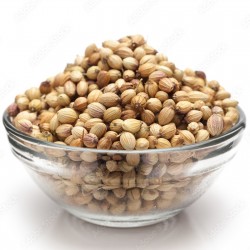
Coriander Seeds (Coriandrum...
السعر
2.05 €
SKU: MHS 117
Seeds Gallery Com,
5/
5
<meta http-equiv="Content-Type" content="text/html; charset=UTF-8" />
<h2><strong>Coriander Seeds Herb (Coriandrum Sativum)</strong></h2>
<h2><span style="color: #ff0000;"><strong>Price for Package of 200 seeds (2g).</strong></span></h2>
<p><b>Coriander</b><span> </span>(<span class="nowrap"><span class="IPA nopopups noexcerpt">/<span><span title="/ˌ/: secondary stress follows">ˌ</span><span title="'k' in 'kind'">k</span><span title="/ɒr/: 'or' in 'moral'">ɒr</span><span title="/i/: 'y' in 'happy'">i</span><span title="/ˈ/: primary stress follows">ˈ</span><span title="/æ/: 'a' in 'bad'">æ</span><span title="'n' in 'nigh'">n</span><span title="'d' in 'dye'">d</span><span title="/ər/: 'er' in 'letter'">ər</span></span>,<span class="wrap"><span> </span></span><span><span title="/ˈ/: primary stress follows">ˈ</span><span title="'k' in 'kind'">k</span><span title="/ɒr/: 'or' in 'moral'">ɒr</span><span title="/i/: 'y' in 'happy'">i</span><span title="/æ/: 'a' in 'bad'">æ</span><span title="'n' in 'nigh'">n</span><span title="'d' in 'dye'">d</span><span title="/ər/: 'er' in 'letter'">ər</span></span>/</span></span>;<sup id="cite_ref-epd_coriander_1-0" class="reference"></sup><span> </span><i>Coriandrum sativum</i>) is an<span> </span>annual<span> </span>herb<span> </span>in the family<span> </span>Apiaceae. It is also known as<span> </span><b>Chinese parsley</b>, and in North America, the stems and leaves are usually called<span> </span><b>cilantro</b><span> </span>(<span class="nowrap"><span class="IPA nopopups noexcerpt">/<span><span title="'s' in 'sigh'">s</span><span title="/ɪ/: 'i' in 'kit'">ɪ</span><span title="/ˈ/: primary stress follows">ˈ</span><span title="'l' in 'lie'">l</span><span title="/æ/: 'a' in 'bad'">æ</span><span title="'n' in 'nigh'">n</span><span title="'t' in 'tie'">t</span><span title="'r' in 'rye'">r</span><span title="/oʊ/: 'o' in 'code'">oʊ</span></span>,<span class="wrap"><span> </span></span>-<span><span title="/ˈ/: primary stress follows">ˈ</span><span title="'l' in 'lie'">l</span><span title="/ɑː/: 'a' in 'father'">ɑː</span><span title="'n' in 'nigh'">n</span></span>-/</span></span>).<sup id="cite_ref-epd_cilantro_2-0" class="reference"></sup><span> </span>All parts of the plant are edible, but the fresh leaves and the dried seeds (as a<span> </span>spice) are the parts most traditionally used in cooking.</p>
<p>Most people perceive the taste of coriander leaves as a tart, lemon/lime taste, but a smaller group of about 3–21% of people tested (depending on ethnicity) think the leaves taste like<span> </span>dish soap, linked to a<span> </span>gene<span> </span>which detects some specific<span> </span>aldehydes<span> </span>that are also used as odorant substances in many soaps and detergents</p>
<h2><span class="mw-headline" id="Botanical_description">Botanical description</span></h2>
<div class="thumb tright">
<div class="thumbinner"><img alt="" src="https://upload.wikimedia.org/wikipedia/commons/thumb/7/7c/Coriandrum_sativum_003.JPG/225px-Coriandrum_sativum_003.JPG" width="225" height="225" class="thumbimage" />
<div class="thumbcaption">
<div class="magnify"></div>
Flowers of<i><span> </span>Coriandrum sativum</i></div>
</div>
</div>
<p>Coriander is native to regions spanning from<span> </span>Southern Europe<span> </span>and<span> </span>Northern Africa<span> </span>to<span> </span>Southwestern Asia. It is a soft plant growing to 50 cm (20 in) tall. The leaves are variable in shape, broadly lobed at the base of the plant, and slender and feathery higher on the flowering stems. The<span> </span>flowers<span> </span>are borne in small<span> </span>umbels, white or very pale pink, asymmetrical, with the petals pointing away from the center of the umbel longer (5–6 mm or 0.20–0.24 in) than those pointing toward it (only 1–3 mm or 0.039–0.118 in long). The<span> </span>fruit<span> </span>is a globular, dry<span> </span>schizocarp<span> </span>3–5 mm (0.12–0.20 in) in diameter. Pollen size is approximately 33 microns.</p>
<div class="thumb tright">
<div class="thumbinner"><img alt="" src="https://upload.wikimedia.org/wikipedia/commons/thumb/6/69/Coriander-2019-5-11_20-17-8-01.jpg/220px-Coriander-2019-5-11_20-17-8-01.jpg" width="220" height="292" class="thumbimage" />
<div class="thumbcaption">
<div class="magnify"></div>
Coriander pollen</div>
</div>
</div>
<h2><span class="mw-headline" id="Etymology">Etymology</span></h2>
<p>First attested in English in the late 14th century, the word "coriander" derives from the<span> </span>Old French:<span> </span><i>coriandre</i>, which comes from<span> </span>Latin:<span> </span><i>coriandrum</i>,<sup id="cite_ref-4" class="reference">[4]</sup><span> </span>in turn from<span> </span>Ancient Greek:<span> </span><span lang="grc" xml:lang="grc">κορίαννον</span>,<span> </span><i>koriannon</i>,<sup id="cite_ref-5" class="reference">[5]</sup><sup id="cite_ref-6" class="reference">[6]</sup><span> </span>derived from<span> </span>Ancient Greek:<span> </span><span lang="grc" xml:lang="grc">κόρις</span>,<span> </span><i>kóris</i><span> </span>(a bed bug), and was given on account of its foetid, bed bug-like smell.<sup id="cite_ref-7" class="reference">[7]</sup><span> </span>The earliest attested form of the word is the<span> </span>Mycenaean Greek<span> </span><i><i>ko-ri-ja-da-na</i></i><sup id="cite_ref-8" class="reference">[8]</sup><span> </span>written in<span> </span>Linear B<span> </span>syllabic script (reconstructed as<span> </span><i><i>koriadnon</i></i>, similar to the name of<span> </span>Minos's daughter<span> </span>Ariadne) which later evolved to<span> </span><i>koriannon</i><span> </span>or<span> </span><i>koriandron</i>,<sup id="cite_ref-Chadwick_9-0" class="reference">[9]</sup><span> </span>and<span> </span><i>koriander</i><span> </span>(German).<sup id="cite_ref-spice_10-0" class="reference">[10]</sup></p>
<p><i><i>Cilantro</i></i><span> </span>is the Spanish word for coriander, also deriving from<span> </span><i>coriandrum</i>. It is the common term in<span> </span>North American<span> </span>English<span> </span>for coriander leaves, due to their extensive use in<span> </span>Mexican cuisine.<sup id="cite_ref-spice_10-1" class="reference">[10]</sup></p>
<h2><span class="mw-headline" id="Origin">Origin</span></h2>
<p>Although native to<span> </span>Iran,<sup id="cite_ref-11" class="reference">[11]</sup><span> </span>coriander grows wild over a wide area of Western Asia and Southern Europe, prompting the comment: "It is hard to define exactly where this plant is wild and where it only recently established itself."<sup id="cite_ref-ZoharyHopf_12-0" class="reference">[12]</sup><span> </span>Fifteen desiccated<span> </span>mericarps<span> </span>were found in the<span> </span>Pre-Pottery Neolithic B<span> </span>level of the<span> </span>Nahal Hemar<span> </span>Cave in<span> </span>Israel, which may be the oldest archaeological find of coriander. About half a litre of coriander mericarps was recovered from the tomb of<span> </span>Tutankhamen, and because this plant does not grow wild in Egypt, Zohary and Hopf interpret this find as proof that coriander was cultivated by the<span> </span>ancient Egyptians.<sup id="cite_ref-ZoharyHopf_12-1" class="reference">[12]</sup></p>
<p>Coriander seems to have been cultivated in Greece since at least the second millennium BC. One of the<span> </span>Linear B<span> </span>tablets recovered from<span> </span>Pylos<span> </span>refers to the species as being cultivated for the manufacture of perfumes; it apparently was used in two forms: as a spice for its seeds and as a herb for the flavour of its leaves.<sup id="cite_ref-Chadwick_9-1" class="reference">[9]</sup><span> </span>This appears to be confirmed by archaeological evidence from the same period; the large quantities of the species retrieved from an<span> </span>Early Bronze Age<span> </span>layer at<span> </span>Sitagroi<span> </span>in<span> </span>Macedonia<span> </span>could point to cultivation of the species at that time.<sup id="cite_ref-13" class="reference">[13]</sup></p>
<h2><span class="mw-headline" id="Uses">Uses</span></h2>
<p>All parts of the plant are edible, but the fresh leaves and the dried seeds are the parts most traditionally used in cooking, Coriander is used in cuisines throughout the world.<sup id="cite_ref-Samuelsson_14-0" class="reference">[14]</sup></p>
<ul class="gallery mw-gallery-packed">
<li>
<ul class="gallery mw-gallery-packed">
<li class="gallerybox">
<div>
<div class="thumb">
<div><img alt="" src="https://upload.wikimedia.org/wikipedia/commons/thumb/f/f8/Corriander_leaves-Cocunut_chutney.jpg/280px-Corriander_leaves-Cocunut_chutney.jpg" width="187" height="140" /></div>
</div>
<div class="gallerytext">
<p>Coriander leaves in coconut<span> </span>chutney</p>
</div>
</div>
</li>
</ul>
</li>
</ul>
<p><span> </span></p>
<ul class="gallery mw-gallery-packed">
<li>
<ul class="gallery mw-gallery-packed">
<li class="gallerybox">
<div>
<div class="thumb">
<div><img alt="" src="https://upload.wikimedia.org/wikipedia/commons/thumb/e/e1/Minty_pani_puri.jpg/280px-Minty_pani_puri.jpg" width="187" height="140" /></div>
</div>
<div class="gallerytext">
<p>Minty pani puri</p>
</div>
</div>
</li>
</ul>
</li>
</ul>
<p><span> </span></p>
<ul class="gallery mw-gallery-packed">
<li class="gallerybox">
<div>
<div class="thumb">
<div><img alt="" src="https://upload.wikimedia.org/wikipedia/commons/thumb/b/be/Onion_Corriander_Paratha.JPG/280px-Onion_Corriander_Paratha.JPG" width="187" height="140" /></div>
</div>
<div class="gallerytext">
<p>Onion coriander<span> </span>paratha</p>
</div>
</div>
</li>
</ul>
<div></div>
<h3><span class="mw-headline" id="Leaves">Leaves</span></h3>
<div class="thumb tleft">
<div class="thumbinner"><img alt="" src="https://upload.wikimedia.org/wikipedia/commons/thumb/5/51/A_scene_of_Coriander_leaves.JPG/220px-A_scene_of_Coriander_leaves.JPG" width="220" height="165" class="thumbimage" />
<div class="thumbcaption">
<div class="magnify"></div>
Coriander leaves</div>
</div>
</div>
<p>The leaves are variously referred to as coriander leaves, fresh coriander, dhania, Chinese parsley, or (in the US and commercially in Canada) cilantro.</p>
<p>Coriander potentially may be confused with<span> </span>culantro<span> </span>(<i>Eryngium foetidum</i><span> </span>L.), an<span> </span>Apiaceae<span> </span>like coriander (<i>Coriandrum sativum</i><span> </span>L.), but from a different<span> </span>genus. Culantro has a distinctly different spiny appearance, a more potent volatile leaf oil<sup id="cite_ref-15" class="reference">[15]</sup><span> </span>and a stronger aroma.</p>
<p>The leaves have a different taste from the seeds, with<span> </span>citrus<span> </span>overtones.<sup id="cite_ref-McGee_16-0" class="reference">[16]</sup></p>
<p>The fresh leaves are an ingredient in many South Asian foods (such as<span> </span>chutneys<span> </span>and salads); in Chinese, Thai, and Burmese dishes; in Mexican cooking, particularly in<span> </span>salsa<span> </span>and<span> </span>guacamole<span> </span>and as a garnish; and in salads in Russia and other<span> </span>CIS<span> </span>countries. In Portugal, chopped coriander is used in the bread soup<span> </span>Açorda, and in India, chopped coriander is a garnish on Indian dishes such as<span> </span><i>dal</i>.<sup id="cite_ref-Moulin_17-0" class="reference">[17]</sup><span> </span>As heat diminishes their flavour, coriander leaves are often used raw or added to the dish immediately before serving. In Indian and Central Asian recipes, coriander leaves are used in large amounts and cooked until the flavour diminishes.<sup id="cite_ref-spice_10-2" class="reference">[10]</sup><span> </span>The leaves spoil quickly when removed from the plant, and lose their aroma when dried or frozen.</p>
<h3><span class="mw-headline" id="Seeds">Seeds</span></h3>
<div class="thumb tleft">
<div class="thumbinner"><img alt="" src="https://upload.wikimedia.org/wikipedia/commons/thumb/8/86/Coriander_Seeds.jpg/220px-Coriander_Seeds.jpg" width="220" height="147" class="thumbimage" />
<div class="thumbcaption">
<div class="magnify"></div>
Dried coriander fruits, often called "coriander seeds" when used as a spice</div>
</div>
</div>
<p>The dry fruits are known as coriander seeds. The word "coriander" in food preparation may refer solely to these seeds (as a spice), rather than to the plant. The seeds have a lemony citrus flavour when crushed, due to<span> </span>terpenes<span> </span>linalool<span> </span>and<span> </span>pinene. It is described as warm, nutty, spicy, and orange-flavoured.</p>
<p>The variety<span> </span><i>C. s. vulgare</i><span> </span>has a fruit diameter of 3–5 mm (0.12–0.20 in), while var.<span> </span><i>C. s. microcarpum</i><span> </span>fruits have a diameter of 1.5–3 mm (0.06–0.12 in). Large-fruited types are grown mainly by tropical and subtropical countries, e.g. Morocco, India, and Australia, and contain a low volatile oil content (0.1-0.4%). They are used extensively for grinding and blending purposes in the spice trade. Types with smaller fruit are produced in temperate regions and usually have a volatile oil content around 0.4-1.8%, so are highly valued as a raw material for the preparation of essential oil.<sup id="cite_ref-18" class="reference">[18]</sup></p>
<p>Coriander is commonly found both as whole dried seeds and in<span> </span>ground<span> </span>form. Roasting or heating the seeds in a dry pan heightens the flavour, aroma, and pungency. Ground coriander seed loses flavour quickly in storage and is best ground fresh. Coriander seed is a spice in<span> </span><i>garam masala</i><span> </span>and<span> </span>Indian<span> </span>curries which often employ the ground fruits in generous amounts together with<span> </span>cumin, acting as a thickener in a mixture called<span> </span><i>dhana jeera</i>.<sup id="cite_ref-19" class="reference">[19]</sup><span> </span>Roasted coriander seeds, called<span> </span><i>dhana dal</i>, are eaten as a snack. They are the main ingredient of the two south Indian dishes<span> </span><i>sambhar</i><span> </span>and<span> </span><i>rasam</i>.</p>
<p>Outside of Asia, coriander seed is used widely in the process for<span> </span>pickling<span> </span>vegetables. In Germany and South Africa (see<span> </span><i>boerewors</i>), the seeds are used while making sausages. In Russia and Central Europe, coriander seed is an occasional ingredient in<span> </span>rye<span> </span>bread (e.g.<span> </span>Borodinsky bread), as an alternative to<span> </span>caraway. The<span> </span>Zuni people<span> </span>of North America have adapted it into their cuisine, mixing the powdered seeds ground with chili and using it as a condiment with meat, and eating leaves as a salad.<sup id="cite_ref-20" class="reference">[20]</sup></p>
<p>Coriander seeds are used in brewing certain styles of beer, particularly some Belgian<span> </span>wheat beers. The coriander seeds are used with orange peel to add a citrus character. Coriander seed is one of the main traditional ingredients in the South African<span> </span>Boerewors, a spiced mixed-meat sausage.</p>
<p>One preliminary study showed coriander<span> </span>essential oil<span> </span>to inhibit<span> </span>Gram-positive<span> </span>and<span> </span>Gram-negative bacteria, including<span> </span><i>Staphylococcus aureus</i>,<span> </span><i>Enterococcus faecalis, Pseudomonas aeruginosa,</i><span> </span>and<span> </span><i>Escherichia coli</i>.<sup id="cite_ref-21" class="reference">[21]</sup></p>
<p>Coriander is listed as one of the original ingredients in the<span> </span>secret formula<span> </span>for<span> </span>Coca-Cola.<sup id="cite_ref-22" class="reference">[22]</sup></p>
<h3><span class="mw-headline" id="Roots">Roots</span></h3>
<div class="thumb tleft">
<div class="thumbinner"><img alt="" src="https://upload.wikimedia.org/wikipedia/commons/thumb/8/84/Coriander_roots.JPG/220px-Coriander_roots.JPG" width="220" height="148" class="thumbimage" />
<div class="thumbcaption">
<div class="magnify"></div>
Coriander roots</div>
</div>
</div>
<p>Coriander<span> </span>roots<span> </span>have a deeper, more intense flavor than the leaves, and are used in a variety of Asian cuisines, especially in<span> </span>Thai dishes<span> </span>such as soups or<span> </span>curry pastes.</p>
<h2><span class="mw-headline" id="Nutrition">Nutrition</span></h2>
<table class="infobox nowrap"><caption>Coriander (cilantro) leaves, raw</caption>
<tbody>
<tr>
<th colspan="2">Nutritional value per 100 g (3.5 oz)</th>
</tr>
<tr>
<th scope="row">Energy</th>
<td>95 kJ (23 kcal)</td>
</tr>
<tr>
<td colspan="2"></td>
</tr>
<tr>
<th scope="row">
<div><b>Carbohydrates</b></div>
</th>
<td>
<div>3.67 g</div>
</td>
</tr>
<tr>
<th scope="row">Sugars</th>
<td>0.87</td>
</tr>
<tr>
<th scope="row">Dietary fiber</th>
<td>2.8 g</td>
</tr>
<tr>
<td colspan="2"></td>
</tr>
<tr>
<th scope="row">
<div><b>Fat</b></div>
</th>
<td>
<div>0.52 g</div>
</td>
</tr>
<tr>
<td colspan="2"></td>
</tr>
<tr>
<th scope="row">
<div><b>Protein</b></div>
</th>
<td>
<div>2.13 g</div>
</td>
</tr>
<tr>
<td colspan="2"></td>
</tr>
<tr>
<th scope="row"><b>Vitamins</b></th>
<td><b>Quantity</b><span><abbr title="Percentage of Daily Value"><b>%DV</b></abbr><sup>†</sup></span></td>
</tr>
<tr>
<th scope="row">Vitamin A equiv.
<div>beta-Carotene</div>
<div>lutein<span> </span>zeaxanthin</div>
</th>
<td>
<div>42%</div>
337 μg
<div>
<div>36%</div>
3930 μg</div>
<div>865 μg</div>
</td>
</tr>
<tr>
<th scope="row">Thiamine<span> </span><span>(B1)</span></th>
<td>
<div>6%</div>
0.067 mg</td>
</tr>
<tr>
<th scope="row">Riboflavin<span> </span><span>(B2)</span></th>
<td>
<div>14%</div>
0.162 mg</td>
</tr>
<tr>
<th scope="row">Niacin<span> </span><span>(B3)</span></th>
<td>
<div>7%</div>
1.114 mg</td>
</tr>
<tr>
<th scope="row">Pantothenic acid<span> </span><span>(B5)</span></th>
<td>
<div>11%</div>
0.57 mg</td>
</tr>
<tr>
<th scope="row">Vitamin B<span>6</span></th>
<td>
<div>11%</div>
0.149 mg</td>
</tr>
<tr>
<th scope="row">Folate<span> </span><span>(B9)</span></th>
<td>
<div>16%</div>
62 μg</td>
</tr>
<tr>
<th scope="row">Vitamin C</th>
<td>
<div>33%</div>
27 mg</td>
</tr>
<tr>
<th scope="row">Vitamin E</th>
<td>
<div>17%</div>
2.5 mg</td>
</tr>
<tr>
<th scope="row">Vitamin K</th>
<td>
<div>295%</div>
310 μg</td>
</tr>
<tr>
<td colspan="2"></td>
</tr>
<tr>
<th scope="row"><b>Minerals</b></th>
<td><b>Quantity</b><span><abbr title="Percentage of Daily Value"><b>%DV</b></abbr><sup>†</sup></span></td>
</tr>
<tr>
<th scope="row">Calcium</th>
<td>
<div>7%</div>
67 mg</td>
</tr>
<tr>
<th scope="row">Iron</th>
<td>
<div>14%</div>
1.77 mg</td>
</tr>
<tr>
<th scope="row">Magnesium</th>
<td>
<div>7%</div>
26 mg</td>
</tr>
<tr>
<th scope="row">Manganese</th>
<td>
<div>20%</div>
0.426 mg</td>
</tr>
<tr>
<th scope="row">Phosphorus</th>
<td>
<div>7%</div>
48 mg</td>
</tr>
<tr>
<th scope="row">Potassium</th>
<td>
<div>11%</div>
521 mg</td>
</tr>
<tr>
<th scope="row">Sodium</th>
<td>
<div>3%</div>
46 mg</td>
</tr>
<tr>
<th scope="row">Zinc</th>
<td>
<div>5%</div>
0.5 mg</td>
</tr>
<tr>
<td colspan="2"></td>
</tr>
<tr>
<th scope="row"><b>Other constituents</b></th>
<td><b>Quantity</b></td>
</tr>
<tr>
<th scope="row">Water</th>
<td>92.21 g</td>
</tr>
<tr>
<td colspan="2"><hr />
<div class="wrap">Link to USDA Database entry</div>
</td>
</tr>
<tr>
<td colspan="2">
<div class="plainlist">
<ul>
<li>Units</li>
<li>μg =<span> </span>micrograms • mg =<span> </span>milligrams</li>
<li>IU =<span> </span>International units</li>
</ul>
</div>
</td>
</tr>
<tr>
<td colspan="2" class="wrap"><sup>†</sup>Percentages are roughly approximated using<span> </span>US recommendations<span> </span>for adults.<span> </span><br /><span class="nowrap"><span>Source: USDA Nutrient Database</span></span></td>
</tr>
</tbody>
</table>
<p>Raw coriander leaves are 92% water, 4%<span> </span>carbohydrates, 2%<span> </span>protein, and less than 1%<span> </span>fat<span> </span>(table). The nutritional profile of coriander seeds is different from the fresh stems or leaves. In a 100 gram reference amount, leaves are particularly rich in<span> </span>vitamin A,<span> </span>vitamin Cand<span> </span>vitamin K, with moderate content of<span> </span>dietary minerals<span> </span>(table). Although seeds generally have lower content of vitamins, they do provide significant amounts of<span> </span>dietary fiber,<span> </span>calcium,<span> </span>selenium,<span> </span>iron,<span> </span>magnesium<span> </span>and<span> </span>manganese.<sup id="cite_ref-23" class="reference">[23]</sup></p>
<h2><span class="mw-headline" id="Taste_and_smell">Taste and smell</span></h2>
<p>The<span> </span>essential oil<span> </span>from coriander leaves and seeds contains mixed<span> </span>polyphenols<span> </span>and<span> </span>terpenes, including<span> </span>linalool<span> </span>as the major constituent accounting for the aroma and flavor of coriander.<sup id="cite_ref-24" class="reference">[24]</sup></p>
<p>Different people may perceive the taste of coriander leaves differently. Those who enjoy it say it has a refreshing, lemony or lime-like flavor, while those who dislike it have a strong aversion to its taste and smell, characterizing it as soapy or rotten.<sup id="cite_ref-McGee_16-1" class="reference">[16]</sup><sup id="cite_ref-25" class="reference">[25]</sup><span> </span>Studies also show variations in preference among different ethnic groups: 21% of East Asians, 17% of Caucasians, and 14% of people of African descent expressed a dislike for coriander, but among the groups where coriander is popular in their cuisine, only 7% of South Asians, 4% of Hispanics, and 3% of Middle Eastern subjects expressed a dislike.<sup id="cite_ref-26" class="reference">[26]</sup></p>
<p>Studies have shown that 80% of identical twins shared the same preference for the herb, but fraternal twins agreed only about half the time, strongly suggesting a genetic component to the preference. In a genetic survey of nearly 30,000 people, two genetic variants linked to perception of coriander have been found, the most common of which is a gene involved in sensing smells.<sup id="cite_ref-27" class="reference">[27]</sup><span> </span>The gene,<span> </span><i>OR6A2</i>, lies within a cluster of olfactory-receptor genes, and encodes a receptor that is highly sensitive to<span> </span>aldehydechemicals. Flavor chemists have found that the coriander aroma is created by a half-dozen or so substances, and most of these are aldehydes. Those who dislike the taste are sensitive to the offending<span> </span>unsaturated<span> </span>aldehydes and at the same time may be unable to detect the aromatic chemicals that others find pleasant.<sup id="cite_ref-28" class="reference">[28]</sup><span> </span>Association between its taste and several other genes, including a bitter-taste receptor, have also been found.<sup id="cite_ref-nature-soapy-taste_3-1" class="reference"></sup><sup id="cite_ref-29" class="reference"></sup></p>
<h2><span class="mw-headline" id="Allergy">Allergy</span></h2>
<p>Some people are allergic to coriander leaves or seeds, having symptoms similar to those of other<span> </span>food allergies.<sup id="cite_ref-aip_30-0" class="reference">[30]</sup><span> </span>In one study, 32% of<span> </span>pin-prick<span> </span>tests in children and 23% in adults were positive for coriander and other members of the family Apiaceae, including<span> </span>caraway,<span> </span>fennel, and<span> </span>celery.<sup id="cite_ref-aip_30-1" class="reference">[30]</sup><span> </span>The allergic symptoms may be minor or life-threatening.</p>
MHS 117 (2g)

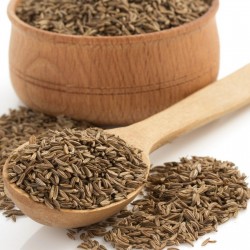
Cumin Seed (Cuminum cyminum)
السعر
1.65 €
SKU: MHS 129
Seeds Gallery Com,
5/
5
<h2><strong>Cumin Seed (Cuminum cyminum)</strong></h2>
<h2 class=""><span style="color: #ff0000;"><strong>Price for Package of 240 (1g) seeds.</strong></span></h2>
<p>Cumin (/ˈkjuːmᵻn/ or UK /ˈkʌmᵻn/, US /ˈkuːmᵻn/), sometimes spelled cummin, (Cuminum cyminum) is a flowering plant in the family Apiaceae, native from the east Mediterranean to India.</p>
<p>Its seeds (each one contained within a fruit, which is dried) are used in the cuisines of many different cultures, in both whole and ground form. It also has many uses as a traditional medicinal plant.</p>
<p>Cumin is the dried seed of the herb Cuminum cyminum, a member of the parsley family. The cumin plant grows to 30–50 cm (12–20 in) tall and is harvested by hand. It is an annual herbaceous plant, with a slender, glabrous, branched stem that is 20–30 cm (8–12 in) tall and has a diameter of 3–5 cm (1 1⁄4–2 in).[9] Each branch has two to three sub-branches. All the branches attain the same height, therefore the plant has a uniform canopy.[9] The stem is coloured grey or dark green. The leaves are 5–10 cm (2–4 in) long, pinnate or bipinnate, with thread-like leaflets. The flowers are small, white or pink, and borne in umbels. Each umbel has five to seven umbellts.[9] The fruit is a lateral fusiform or ovoid achene 4–5 mm (1⁄6–1⁄5 in) long, containing two mericarps with a single seed.[9] Cumin seeds have eight ridges with oil canals.[9] They resemble caraway seeds, being oblong in shape, longitudinally ridged, and yellow-brown in colour, like other members of the Umbelliferae family such as caraway, parsley, and dill.</p>
<p><strong>Etymology</strong></p>
<p>The English "cumin" is derived from the Old English, from Latin cuminum,[3] which is the Latinisation of the Greek κύμινον (kyminon),[4] cognate with Hebrew כמון (kammon) and Arabic كمون (kammūn).[5] The earliest attested form of the word in Greek is the Mycenaean.</p>
<div>
<table border="1" cellspacing="0" cellpadding="0">
<tbody>
<tr>
<td colspan="2" valign="top" width="100%">
<h3 align="center"><span style="color: #008000;">Sowing Instructions</span></h3>
</td>
</tr>
<tr>
<td valign="top" nowrap="nowrap">
<p align="center"><span style="color: #008000;"><strong>Propagation:</strong></span></p>
</td>
<td valign="top">
<p align="center"><span style="color: #008000;">Seeds</span></p>
</td>
</tr>
<tr>
<td valign="top" nowrap="nowrap">
<p align="center"><span style="color: #008000;"><strong>Pretreat:</strong></span></p>
</td>
<td valign="top">
<p align="center"><span style="color: #008000;">0</span></p>
</td>
</tr>
<tr>
<td valign="top" nowrap="nowrap">
<p align="center"><span style="color: #008000;"><strong>Stratification:</strong></span></p>
</td>
<td valign="top">
<p align="center"><span style="color: #008000;">0</span></p>
</td>
</tr>
<tr>
<td valign="top" nowrap="nowrap">
<p align="center"><span style="color: #008000;"><strong>Sowing Time:</strong></span></p>
</td>
<td valign="top">
<p align="center"><span style="color: #008000;">all year round</span></p>
</td>
</tr>
<tr>
<td valign="top" nowrap="nowrap">
<p align="center"><span style="color: #008000;"><strong>Sowing Depth:</strong></span></p>
</td>
<td valign="top">
<p align="center"><span style="color: #008000;"><span style="color: #ff0000;"><strong>Needs Light to germinate!</strong></span> Just sprinkle on the surface of the substrate + gently press</span></p>
</td>
</tr>
<tr>
<td valign="top" nowrap="nowrap">
<p align="center"><span style="color: #008000;"><strong>Sowing Mix:</strong></span></p>
</td>
<td valign="top">
<p align="center"><span style="color: #008000;">Coir or sowing mix + sand or perlite</span></p>
</td>
</tr>
<tr>
<td valign="top" nowrap="nowrap">
<p align="center"><span style="color: #008000;"><strong>Germination temperature:</strong></span></p>
</td>
<td valign="top">
<p align="center"><span style="color: #008000;">20-25°C</span></p>
</td>
</tr>
<tr>
<td valign="top" nowrap="nowrap">
<p align="center"><span style="color: #008000;"><strong>Location:</strong></span></p>
</td>
<td valign="top">
<p align="center"><span style="color: #008000;">bright + keep constantly moist not wet</span></p>
</td>
</tr>
<tr>
<td valign="top" nowrap="nowrap">
<p align="center"><span style="color: #008000;"><strong>Germination Time:</strong></span></p>
</td>
<td valign="top">
<p align="center"><span style="color: #008000;">1 - 8 weeks</span></p>
</td>
</tr>
<tr>
<td valign="top" nowrap="nowrap">
<p align="center"><span style="color: #008000;"><strong>Watering:</strong></span></p>
</td>
<td valign="top">
<p align="center"><span style="color: #008000;">Water regularly during the growing season</span></p>
</td>
</tr>
<tr>
<td valign="top" nowrap="nowrap"> </td>
<td valign="top">
<p align="center"><span style="color: #008000;"><strong><em>Copyright © 2012 Seeds Gallery - Saatgut Galerie - Galerija semena. </em></strong></span></p>
<p align="center"><span style="color: #008000;"><strong><em></em><em>All Rights Reserved.</em></strong></span></p>
</td>
</tr>
</tbody>
</table>
<p> </p>
</div>
<p><span style="font-size: 10pt;"> </span></p><script src="//cdn.public.n1ed.com/G3OMDFLT/widgets.js"></script>
MHS 129 (1g)





